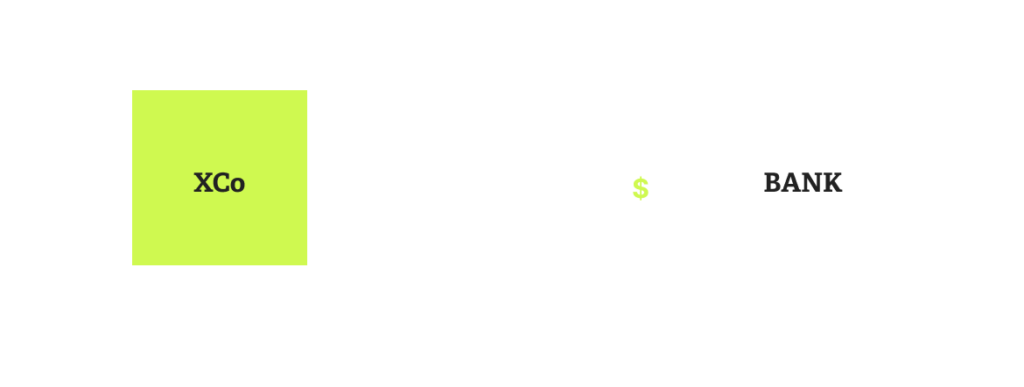
In the article below concerning the conduct of CDD in a corporate banking environment, we examine, in the context of various deal scenarios, against which counterparties CDD must be conducted.
Constructing a CDD framework for corporate business
Given the complexity of many modern financial transactions and structures, it may not be immediately clear to your staff who the corporate customer actually is, and so this is something which will need to be spelled out in your policy documents and your training.
Who is the customer?
In the type of relationship depicted in Figure 1, the answer is straightforward. The customer is a company called X Co that is placing deposits with and taking loans from the bank. However, things may not always be so obvious, so here are a few examples of different types of financial transactions which could be included in policy documentation to guide staff on ‘Who is my customer?’

Figure 1
Examples
Case 1
AlnaBank buys from K Bank the loan portfolio of WonderTaste Limited, which is in financial difficulties and requires a debt restructuring which K Bank is not prepared to provide. According to the workout deal, in addition to acquiring the existing loans, AlnaBank is also to provide an additional credit line of $20 million.
KBank and WonderTaste are both clearly candidates for CDD. But which of these should the CDD be conducted against, or is it both?
The answer in this case is that CDD must be conducted against both counterparties, KBank and WonderTaste. AlnaBank is receiving and paying for financial assets from KBank, and WonderTaste will actually be opening accounts and (hopefully) repaying loans.
Case 2
The hi-tech fund of AlnaBank Growth Ventures Limited (AGVL), AlnaBank’s private equity arm, receives funds from X Limited, Y Limited and Z Limited and invests them in Advance Software Limited, so as to acquire a 65 per cent stake.
The candidates for CDD then are, respectively, X Limited, Y Limited, Z Limited and Advance Software Limited. But against which one should AlnaBank conduct CDD?
The answer in this case is that CDD must be conducted against X Limited, Y Limited and Z Limited since they are the entities from whom funds are being received as part of the investment process. Normally there would be no requirement to conduct due diligence against investee companies such as Advance Software Limited, nevertheless AGVL would be wise to undertake integrity checks against Advance Software before making the investment.
Case 3
Joyful Bank, Beijing branch, sets up SWIFT and tested telex arrangements with AlnaBank in India, which are also to be utilised by Joyful Bank’s New York and London branches. Joyful Bank is incorporated in the People’s Republic of China.
The possibilities for CDD here, therefore, are the three different branches of Joyful Bank in Beijing, New York and London. Against which must AlnaBank conduct CDD?
The answer here (in the absence of more stringent local requirements or separate subsidiary status for each branch AlnaBank – you would need to check) is that Joyful Bank would constitute a single legal entity, and as such CDD need only be conducted against that entity, i.e. there would be no requirement to conduct individual due diligence against each of the overseas branches.
Case 4
AlnaBank sells corporate bonds issued by Timeless Textiles to Excel Investments Limited, an investment firm. AlnaBank purchased the bonds in the secondary market from Alpha Investments Co Limited.
AlnaBank could conduct CDD against Timeless Textiles, Excel Investments or Alpha Investments. So against whom is CDD required?
The answer in this case is that CDD must be conducted by AlnaBank against both Excel Investments and Alpha Investments, as the subsequent purchaser and initial seller, respectively, of the bonds in question. This is because there is a direct business relationship between AlnaBank and these two entities involving the receipt of funds (from Excel Investments) and assets with value (from Alpha Investments). There is no requirement for AlnaBank to conduct CDD against the initial issuer, Timeless Textiles, because there is no business relationship between the two.
Case 5
The Habibian Brandy Company in Yerevan, Armenia, is exporting brandy to Party Pubs Limited in Thailand. AlnaBank is advising a letter of credit issued by Thailand Bank on behalf of Party Pubs Limited.
CDD would be possible against The Habibian Brandy Company, against Thailand Bank and against Party Pubs Limited. Against whom should AlnaBank conduct its CDD?
The answer in this case is Thailand Bank, since according to the structure of such transactions, Thailand Bank will have instructed AlnaBank, which will be receiving funds from it. There is no customer or other business relationship between AlnaBank and either the Habibian Brandy Company or Party Pubs Limited which, although lying at the commercial heart of the transaction, are not customers of AlnaBank. However, applying risk-based principles, limited due diligence such as media searches should be considered against these non-customer third-parties as well as name screening.
Case 6
AlnaBank is the receiving bank on a rights issue being arranged by another bank on behalf of its client, Alpha Limited. In the opening stages of the issue, the following applications are received:
| Applicant name | Amount ($) |
| X Limited | 300,000 |
| Y Limited | 70,000 |
| Mrs Z | 900 |
CDD would be possible against all three of the above, but against whom should AlnaBank conduct it? The answer in this case would be X Limited and Y Limited, but not Mrs Z. Why? Because these are one-off transactions and if the issue were oversubscribed, AlnaBank would have to return X Limited’s and Y Limited’s subscription funds which in each case would be above AlnaBank’s maximum threshold for conducting one-off transactions without undertaking customer due diligence This, of course, would be a potential form of money laundering.
CDD is not required in this case against Mrs Z, however, since the funds which would have to be returned to her in the event of an over-subscription would be below the relevant threshold.
In this case, no CDD would be required against Alpha Limited either, since according to the structure of such transactions, AlnaBank would have no direct business relationship with Alpha Limited as the issuer.
Note: had X Limited’s and Y Limited’s funds come from accounts which they held at regulated financial institutions in countries which AlnaBank deemed to have a good, strong AML regulatory framework, then it would be entitled in its policies to rely on the CDD conducted by those financial institutions (as permitted under Recommendation 17 of the FATF standards). However, AlnaBank would have to satisfy itself that copies of relevant documentation would be available immediately upon request. It should also bear in mind that, notwithstanding its operation of such ‘reliance’ provisions, it would still remain legally responsible for any negative outcome.
Case 7
AlnaBank is the lead manager in the syndication of a loan to Vessyan Textiles, a listed company. The other syndicate banks are Blue Bank, Green Bank and Yellow Bank.
CDD is possible against Vessyan Textiles and the syndicate banks, so against whom should it be conducted?
The correct answer is Vessyan Textiles, which is actually entering into a transactional relationship with AlnaBank. No CDD is required against the syndicate banks since, according to the structure of a syndicated transaction, they do not enter into a transactional relationship with AlnaBank. However, again on risk-based principles, some limited due diligence (name screening and adverse media searches) should be considered on the other members of the syndicate.
Tim Parkman
Director, Client Delivery
Marker AI is a complete digital onboarding and KYC refreshment platform that comes with know-how like this built in. Click here to make an enquiry.

